Exploring Specialized Socks for Hyperhidrosis Relief
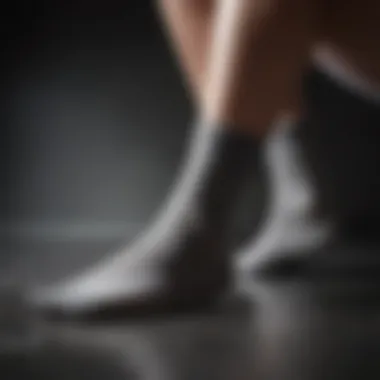
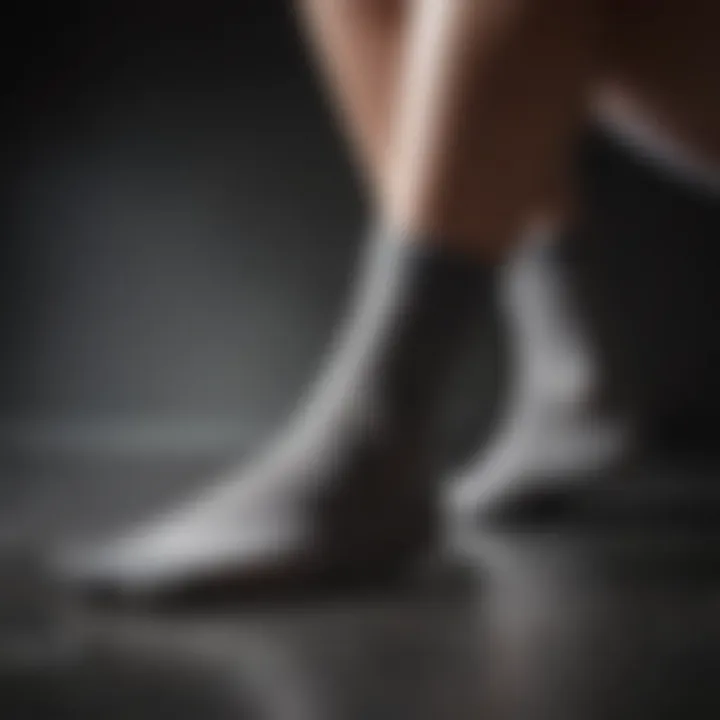
Intro
Hyperhidrosis is a condition that affects countless individuals, manifesting as excessive sweating in different areas of the body. It can be a source of discomfort and even embarrassment for many. While various treatments exist, a practical solution lies in the use of specialized socks designed to manage moisture. This article delves into how these socks can aid those dealing with hyperhidrosis, pinpointing their physical benefits as well as enhancements to mental well-being.
Key Benefits
Physical Health Benefits
Socks engineered for hyperhidrosis are not merely a comfort accessory; they can have substantial health benefits. The unique materials used in these socks, such as moisture-wicking fabrics, facilitate the evaporation of sweat, keeping the feet dry and preventing skin irritation. This can help reduce the risk of fungal infections, a common concern for those with hyperhidrosis. Moreover, the right socks can help maintain proper foot temperature, which may contribute to overall foot health.
Mental Well-being Enhancements
The psychological impact of hyperhidrosis cannot be overstated. Excessive sweating can lead to anxiety and social withdrawal. Wearing specialized socks may offer relief, allowing individuals to feel more secure and confident in their daily interactions. By addressing discomfort, these socks can aid in restoring a sense of normalcy and freedom in activities such as exercising, socializing, or simply going about one’s day.
"Comfort is not a luxury; it is a necessity for maintaining both physical and mental health."
In summary, investing in proper footwear solutions goes beyond superficial comfort. It promises a more holistic approach to managing the symptoms of hyperhidrosis, fostering the potential for a more enriching daily life.
Practical Tips
Selecting the Right Socks
When choosing socks for hyperhidrosis, consider the following:
- Moisture-wicking materials: Look for socks made of synthetic fibers like polyester or specialized blends that enhance moisture control.
- Breathability: Ensure your socks promote airflow to reduce heat and moisture buildup.
- Fit: Opt for socks with a snug fit, but not overly tight, to avoid skin irritation.
Care and Maintenance
To maintain the effectiveness of specialized socks, adhere to these care tips:
- Wash frequently: Keeping socks clean helps remove sweat and bacteria.
- Air dry: Avoid tumble drying, which may degrade moisture-wicking properties.
- Store properly: Keep them in a cool, dry place to prevent mildew.
Additional Strategies for Managing Symptoms
In conjunction with specialized socks, consider these strategies:
- Stay hydrated: Proper hydration may help regulate body temperature.
- Use antiperspirant: Products specifically formulated for feet can reduce sweat production.
- Choose appropriate footwear: Select shoes made from breathable materials to complement the socks.
By understanding the benefits of specialized socks for hyperhidrosis and implementing practical tips for their use and care, individuals can greatly enhance their daily comfort and overall well-being.
Understanding Hyperhidrosis
Hyperhidrosis is a condition characterized by excessive sweating, disrupting daily life for many individuals. Understanding this condition is crucial in identifying effective management strategies, including specialized socks. As sweat can lead to various foot problems, addressing hyperhidrosis is essential not only from a comfort perspective but also for overall foot health.
Definition and Overview of Hyperhidrosis
Hyperhidrosis refers to the abnormal increase in sweating, which can occur even in the absence of heat or exertion. It affects individuals physically and psychologically. Those suffering from hyperhidrosis often report anxiety and embarrassment due to their condition. Being informed about hyperhidrosis facilitates better choices in products such as socks, which can specifically cater to individuals' needs.
Types of Hyperhidrosis
Primary Hyperhidrosis
Primary hyperhidrosis is a condition where excessive sweating occurs without an underlying health issue. This form commonly affects areas such as palms, feet, and armpits. The key characteristic of primary hyperhidrosis is its localized nature; it does not stem from other illnesses, making its causes and triggers often genetic. In the context of this article, understanding primary hyperhidrosis is beneficial because it affects a significant portion of the population. This form often leads to frequent purchasing of specialized socks, as individuals seek solutions to mitigate sweat.
Secondary Hyperhidrosis
Secondary hyperhidrosis, on the other hand, is heat or sweat induced by other medical conditions. This might include hormonal changes, medications, or systemic illnesses. It can affect the entire body instead of specific areas. Recognizing secondary hyperhidrosis is important because it can lead to different needs in terms of managing foot sweat. The influence of existing health issues gives this type unique considerations in the selection of socks designed for hyperhidrosis.
Causes and Triggers
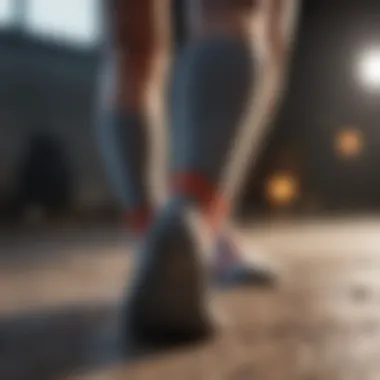

Genetic Factors
Genetic factors play a significant role in the development of hyperhidrosis. Studies show that individuals with a family history of hyperhidrosis are more likely to experience the condition themselves. This connection highlights the inherited nature of sweat response, making it relevant for those researching their condition. Understanding these elements enhances product selection by identifying sock types suitable for their situation and comfort levels.
Environmental Influences
Environmental influences can exacerbate hyperhidrosis. Factors such as climate, temperature, and humidity directly affect sweat levels. Those living in warmer climates may find their condition more challenging to manage. Recognizing these influences underlines the importance of choosing moisture-wicking and breathable socks to aid in sweat management during various environmental conditions.
Health Conditions
Existing health conditions can intensify symptoms of hyperhidrosis, leading to further complexities. Conditions like diabetes or thyroid disorders may increase sweating, making it crucial to understand these connections. For individuals experiencing these related health challenges, making informed sock choices becomes even more significant to minimize discomfort and prevent complications such as fungal infections.
The Importance of Foot Care in Hyperhidrosis
Addressing foot care in hyperhidrosis is crucial for both physical comfort and overall health. Individuals with this condition experience excessive sweating on their feet, leading to a range of potential complications. Thus, a proactive approach to foot care can mitigate these effects, enhance comfort, and contribute to greater confidence in daily activities.
Excessive sweating creates a moist environment on the feet. This can lead to a variety of problems that can significantly affect an individual's quality of life. Regular foot care routines can help reduce these risks and maintain foot health.
Impacts of Excessive Sweating on Feet
Excessive sweating can lead to numerous issues. The most immediate distress comes from the discomfort associated with sweaty feet, which can make wearing shoes for extended periods unbearable. Additionally, moisture can accumulate between the toes, creating a perfect breeding ground for bacteria and fungi.
Over time, this can result in complications such as athlete's foot, fungal infections, and skin irritation.
Common Issues Faced by Individuals with Hyperhidrosis
Understanding the common issues associated with hyperhidrosis helps in crafting effective foot care strategies.
Athlete's Foot
Athlete's foot is a fungal infection that thrives in damp environments. The condition often manifests as itching, burning, or stinging between the toes or on the soles of the feet. This contributes to the larger issue of foot care in hyperhidrosis by exacerbating discomfort. It is crucial to recognize athlete's foot early, as it can lead to further skin complications if left untreated.
Fungal Infections
Fungal infections are a significant concern for those with hyperhidrosis. The excessive moisture in the shoes provides a breeding ground for various types of fungi. Symptoms can include redness, peeling, and intense itching. These infections can turn chronic, creating a cycle of discomfort that further complicates the management of sweat and foot hygiene.
Skin Irritation
Skin irritation occurs when the skin remains in constant contact with moisture. Common signs include redness, blisters, and peeling skin. This irritation can lead to secondary infections, which complicate the overall foot care strategy for individuals dealing with hyperhidrosis. Managing moisture effectively and avoiding products that irritate the skin are essential steps in preventing irritation.
"Ignoring foot care in hyperhidrosis can lead to a cascade of discomfort and health issues. Proactive care is key to managing symptoms effectively."
The essential takeaway is that diligent foot care is not just about managing sweat; it is about preventing the cascading effects that arise from excessive moisture. By understanding the impacts of sweating and addressing common issues head-on, individuals can make informed choices that contribute to better foot health.
Types of Socks for Hyperhidrosis
Understanding the types of socks available for individuals with hyperhidrosis is crucial to effectively managing the condition. Each type of sock serves a unique purpose and addresses different needs associated with excessive sweating. Proper selection can maintain dryness, enhance comfort, and promote better foot health.
Moisture-Wicking Socks
Moisture-wicking socks are designed to draw sweat away from the skin. They utilize advanced fabric technology that allows moisture to evaporate quickly, keeping feet dry and comfortable. For individuals with hyperhidrosis, this can significantly reduce discomfort and the growth of bacteria and fungi. These socks often feature blends of synthetic fibers, offering durability and efficient moisture management.
Anti-Bacterial Socks
Anti-bacterial socks incorporate special treatments or materials that help inhibit the growth of odor-causing bacteria. This is particularly important for those with hyperhidrosis as excessive moisture fosters bacterial growth, leading to unpleasant odors. Cotton, treated with anti-bacterial agents, is commonly used in these socks, providing a layer of protection against foot odor and skin irritations.
Compression Socks
Compression socks can also be beneficial for individuals with hyperhidrosis. While their primary purpose is to improve circulation, they can subtly assist in moisture management by fitting snugly against the foot and leg. The added pressure may help in some cases with blood flow, which indirectly supports the overall health of feet that sweat excessively. These socks are often made from elastic materials that provide flexibility and comfort during wear.
Breathable Materials


Breathable materials play an essential role in sock design for hyperhidrosis. These materials allow air flow, reducing heat buildup and moisture retention.
Bamboo
Bamboo is gaining popularity in the realm of cozy clothing, including socks. The natural properties of bamboo allow it to absorb moisture, which helps in keeping feet dry. Bamboo is also eco-friendly and soft against the skin, reducing irritation. However, one should note that bamboo socks may not be as durable as synthetic options when subjected to frequent washing and wear.
Merino Wool
Merino wool is celebrated for its excellent breathability and moisture-wicking properties. It can keep feet warm during cool days yet manages to remain comfortable in heat. This natural fiber reduces odors due to its antibacterial properties. While merino wool socks can be on the pricier side, their unique features make them a worthwhile investment for long-term use.
Synthetic Blends
Synthetic blends often combine several fibers, such as polyester and nylon, to create socks that excel in comfort and durability. They are usually lightweight and designed to handle moisture effectively, making them suitable for active individuals. The challenge, however, is that some synthetic options may not provide as much breathability as their natural counterparts. This trade-off between moisture control and ventilation should be carefully considered.
Materials and Features to Look For
Choosing the right socks when dealing with hyperhidrosis is critical. The materials and features of socks can significantly impact comfort and effectiveness in managing excessive sweating. Understanding what to look for in socks helps individuals make better choices tailored to their unique needs. This section explores the nuances of materials and characteristics that contribute to the functionality of socks designed for hyperhidrosis.
Benefits of Synthetic Fibers
Synthetic fibers, such as polyester and nylon, are often integral to specialized socks for hyperhidrosis. One primary advantage of these materials is their moisture-wicking properties. They effectively pull moisture away from the skin and disperse it across the fabric surface, allowing for rapid evaporation. This action can help keep feet drier and more comfortable throughout the day.
Additionally, synthetic fibers are usually more durable than natural materials. They resist wear and tear, maintaining performance even after multiple washes. This quality is crucial for individuals who rely on their socks daily. Furthermore, many synthetic options are designed with antibacterial treatments, minimizing odor—a common concern for those with excessive foot sweating.
Natural Fibers and Their Advantages
Natural fibers like cotton, bamboo, and merino wool also have unique benefits. Cotton is widely known for its softness and breathability. It can absorb moisture well, making it a comfortable choice for casual wear. However, cotton may retain moisture against the skin longer than some synthetic options, which can lead to discomfort in cases of severe sweating.
Bamboo fibers are gaining popularity due to their natural antibacterial and moisture-wicking properties. They can regulate temperature and moisture, offering a soft feel against the skin. Merino wool is not only breathable but also keeps feet insulated in colder environments while managing moisture effectively. Though often pricier, these natural fibers can be valuable additions for those looking to balance comfort and functionality.
Comfort and Fit Considerations
When selecting socks, comfort and fit cannot be overstated. Socks should have a snug yet comfortable fit, ensuring they stay in place throughout wear. Loose socks can cause friction, leading to blisters or skin irritation. A proper fit aids in moisture management as well. Socks that are too tight may restrict circulation, aggravating discomfort.
Consideration of seam placement is also vital. Flat seams or seamless construction reduce the risk of irritation, especially for individuals who may be particularly sensitive. Additionally, look for socks with cushioning in high-impact areas like the heel and toe, as this can enhance comfort, especially during extended periods of wear.
Overall, selecting the right materials and features in socks will contribute to managing hyperhidrosis effectively. Proper knowledge in this area ensures a more comfortable and healthier experience.
Benefits of Specialized Socks
Specialized socks serve a significant role for individuals dealing with hyperhidrosis. Wearing the right socks can lead to increased comfort, improved foot health, and higher confidence levels. These benefits contribute to overall well-being in daily activities and can influence both physical and emotional aspects of a person's life. Each benefit is interconnected. Understanding them can help people choose suitable products and encourage better management of their symptoms.
Enhanced Comfort
Comfort is paramount when selecting socks for hyperhidrosis. Excessive sweating can create discomfort due to dampness, irritation, and an overall lack of temperature regulation. Specialized socks are designed with features that help wick away moisture. Materials like bamboo and specific synthetics pull sweat away from the skin. When feet remain dry, it reduces the friction that can cause blisters or hot spots. Additionally, many of these socks have cushioning, providing additional comfort when standing or walking for long durations. The result is a more pleasant experience in daily activities, as the wearer is less distracted by discomfort.
Improved Foot Health
Wearing socks suited for hyperhidrosis can contribute positively to foot health. Excess moisture can lead to various issues, such as fungal infections, athlete’s foot, and skin irritation. Specialized socks, particularly those designed with antibacterial properties, combat the growth of harmful bacteria and fungi. This proactive approach helps minimize the risks of infections. Moreover, such socks often come with arch support and cushioning that protect vulnerable areas of the feet. When feet are healthy, individuals can engage more freely in their activities without fear of pain or complications.
Increased Confidence
Confidence is strongly affected by our physical comfort and health. People struggling with hyperhidrosis often feel self-conscious about foot odor or visible sweat. Specialized socks can alleviate these concerns, allowing individuals to feel more at ease. By choosing appropriate socks, one can manage sweat effectively and prevent issues related to foot hygiene. This small but meaningful shift can empower individuals, reducing anxiety in social situations. Ultimately, feeling confident can lead to better engagement in activities, whether it be at work, exercise, or social gatherings.
"Investing in the right socks is not just a matter of comfort; it is a step toward enhancing overall well-being and confidence."
Understanding these benefits allows individuals to make informed decisions when selecting socks tailored to their needs. By doing so, they can improve their overall quality of life significantly.
Caring for Hyperhidrosis Socks
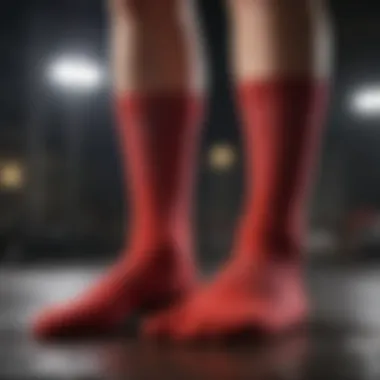
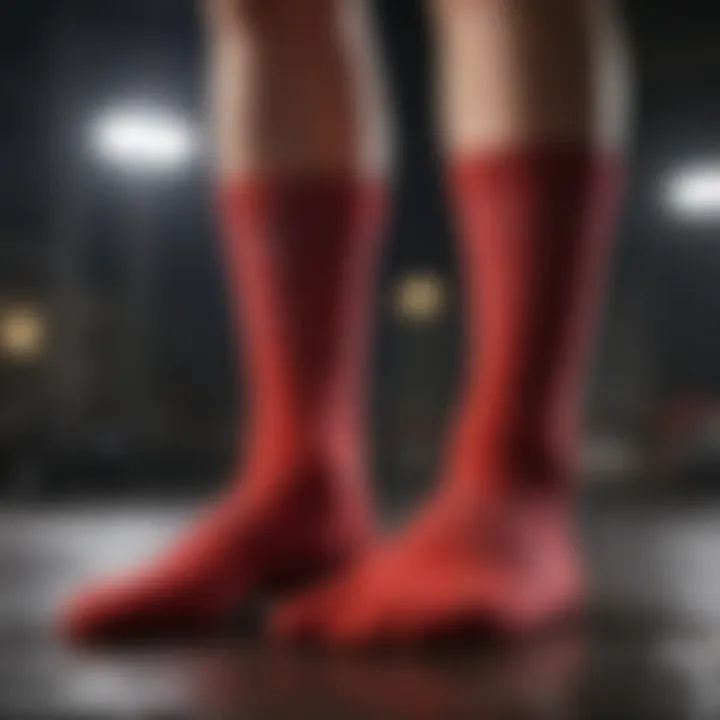
Caring for socks designed for hyperhidrosis is crucial to maximizing their effectiveness. Proper care not only extends the life of the socks but also ensures they continue to perform well in moisture management. When socks are not cared for correctly, materials can break down and lose their properties. This can lead to increased discomfort and even worsen the symptoms of hyperhidrosis.
In this section, we will delve into specific washing instructions, drying techniques, and storage recommendations that are important for maintaining specialized hyperhidrosis socks.
Washing Instructions
When it comes to washing hyperhidrosis socks, following the manufacturer's guidelines is essential. Here are some general instructions to consider:
- Use Cold Water: Always wash socks in cold water. Warm or hot water can damage synthetic fibers and diminish their moisture-wicking abilities.
- Gentle Cycle: Select a gentle wash cycle on your washing machine. This minimizes wear and tear on the fabric and helps maintain the integrity of the fibers.
- Avoid Fabric Softeners: Fabric softeners can create a film on the socks, reducing their breathability. This can trap moisture instead of wicking it away.
- Separate from Heavy Fabrics: Wash your socks separately from heavier items like towels or jeans. This prevents potential snagging and abrasion.
Drying Techniques
Proper drying techniques are vital for keeping hyperhidrosis socks in optimal condition. Here are some best practices to follow:
- Air Dry Whenever Possible: The recommended method for drying is to air dry the socks. Lay them flat on a clean surface or hang them to dry. This helps maintain their shape and performance.
- Avoid Direct Sunlight: When air drying, avoid exposing socks to direct sunlight, as UV rays can weaken the fibers.
- Do Not Use a Dryer: Avoid putting hyperhidrosis socks in the dryer. The heat can damage synthetic fibers, leading to a loss of moisture-wicking abilities and overall elasticity.
Storage Recommendations
Storing socks properly can prolong their lifespan and maintain their characteristics. Consider the following guidelines:
- Keep in a Dry Place: Always store socks in a dry area. This helps prevent the development of mildew, which can be a concern given the nature of hyperhidrosis.
- Avoid Compression: Do not fold or compress socks tightly. Store them loosely to maintain their shape and fabric integrity.
- Use Breathable Containers: If using storage bins, make sure they are breathable or provide some air circulation to maintain freshness.
Remember: Proper care and maintenance of hyperhidrosis socks can significantly impact their performance. By washing, drying, and storing them appropriately, you enhance their effectiveness in managing sweat and keeping your feet comfortable.
Additional Strategies for Managing Hyperhidrosis
Managing hyperhidrosis effectively requires a multi-faceted approach. While specialized socks play a vital role, additional strategies can enhance overall comfort and control of symptoms. These strategies encompass lifestyle adjustments, dietary considerations, and professional treatment options. Each element delivers unique benefits that support better management of excessive sweating. Understanding and incorporating these strategies can lead to significant improvements in daily life for individuals affected by hyperhidrosis.
Lifestyle Adjustments
Adapting daily routines is crucial for those dealing with hyperhidrosis. Simple changes can have a profound impact on symptom management. For instance, wearing loose-fitting clothes can help minimize sweat accumulation and allow for better air circulation. Opting for moisture-wicking fabrics not only in socks but also in clothing can aid in keeping the body dry.
Regular physical activity is also important, but it should be balanced with the recognition of personal limits. Staying hydrated is crucial to support thermoregulation. Furthermore, practicing relaxation techniques, such as meditation and breathing exercises, may help manage stress—a known trigger for sweating.
Dietary Considerations
Diet plays an essential role in managing hyperhidrosis. Certain foods can exacerbate sweating, while others can help. It is wise to limit the intake of spicy foods, caffeine, and alcohol. These substances may increase body temperature and stimulate sweat glands. Instead, incorporating foods high in fiber and hydration, such as fruits and vegetables, is beneficial.
Regular meals can also help regulate metabolism and body temperature. Staying well-hydrated assists the body in maintaining a cooler temperature, thus potentially reducing sweating episodes.
Professional Treatment Options
For those seeking more structured assistance, professional treatments can be viable options. Various procedures are available, each with its merits and drawbacks. Here are some common options:
Antiperspirants
Antiperspirants are a popular choice for managing hyperhidrosis. They work by blocking sweat glands to reduce perspiration. The key characteristic of clinical-strength antiperspirants is the higher concentration of aluminum chloride. This feature makes them more effective than standard products. They can be applied to feet, palms, and underarms, targeting the most problematic areas. However, it is essential to note that they may cause skin irritation in some users, warranting caution during use.
Botox Injections
Botox injections offer a unique method for reducing excessive sweating. This treatment involves injecting botulinum toxin into specific areas where sweating occurs. Its key characteristic is the paralysis effect on sweat glands, significantly lowering sweat production. Many find Botox to be an effective and long-lasting solution, often providing relief for several months. However, potential side effects include pain at the injection site and temporary muscle weakness, which should be discussed with a healthcare provider prior to treatment.
Iontophoresis
Iontophoresis is another effective treatment specifically for localized sweat problems, such as palms and feet. This method involves using a device that passes a mild electrical current through water and into the skin’s surface. Its unique feature is its ability to temporarily block the sweat glands. Iontophoresis is considered safe and non-invasive, and it can show positive results after several sessions. However, frequent treatments may be necessary to maintain results, which can be a drawback for some individuals.
Each of these professional treatments requires consultation with a healthcare provider to determine suitability based on individual conditions.
Ending
In summary, the discussion here emphasizes the crucial role of specialized socks in managing hyperhidrosis. Given the unique challenges faced by individuals with excessive sweating, selecting the appropriate socks can significantly enhance comfort and foot health. Specifically, socks designed for moisture-wicking, antibacterial properties, and breathability are essential for keeping feet dry and free from irritation.
Moreover, understanding the recommended care and maintenance practices for these socks is vital. Proper washing and drying can ensure that the socks perform at their best, extending their lifespan.
"Investing in quality socks tailored for hyperhidrosis can transform daily experiences, providing not just comfort, but also confidence."
Finally, while specialized socks provide numerous benefits, they are part of a broader strategy to manage hyperhidrosis effectively. Lifestyle changes, dietary adjustments, and professional treatments work in concert with the right footwear choices to help individuals cope with their condition. The knowledge presented in this article aims to empower readers to make informed decisions, significantly improving their quality of life.















